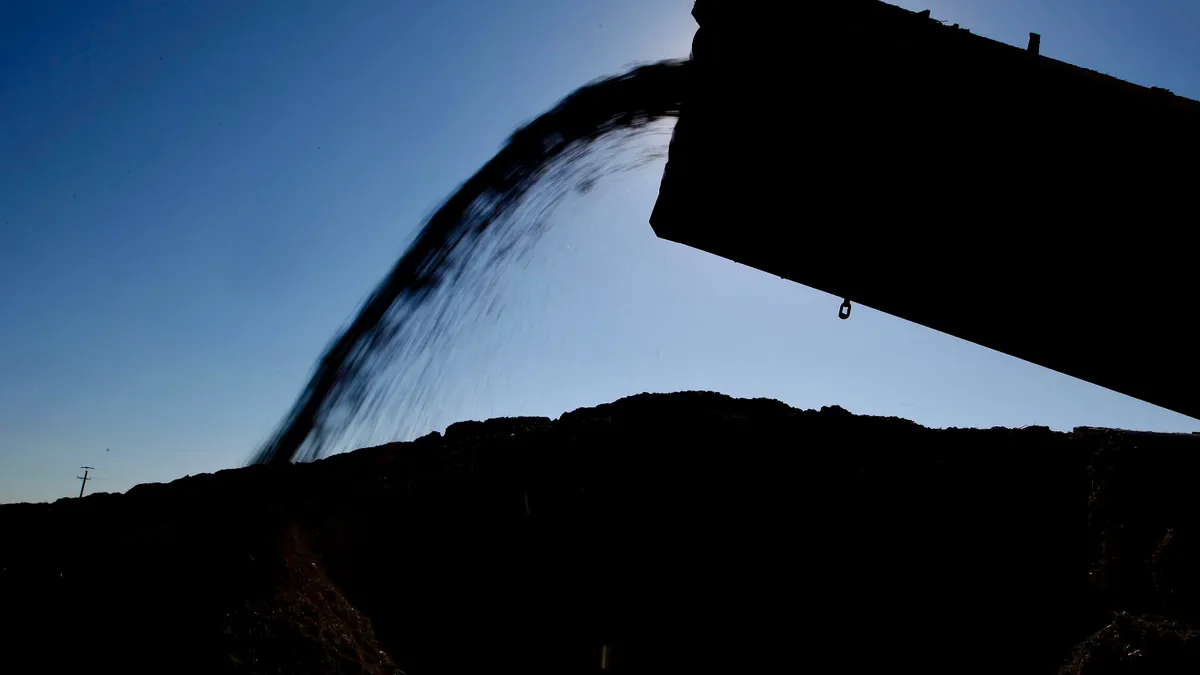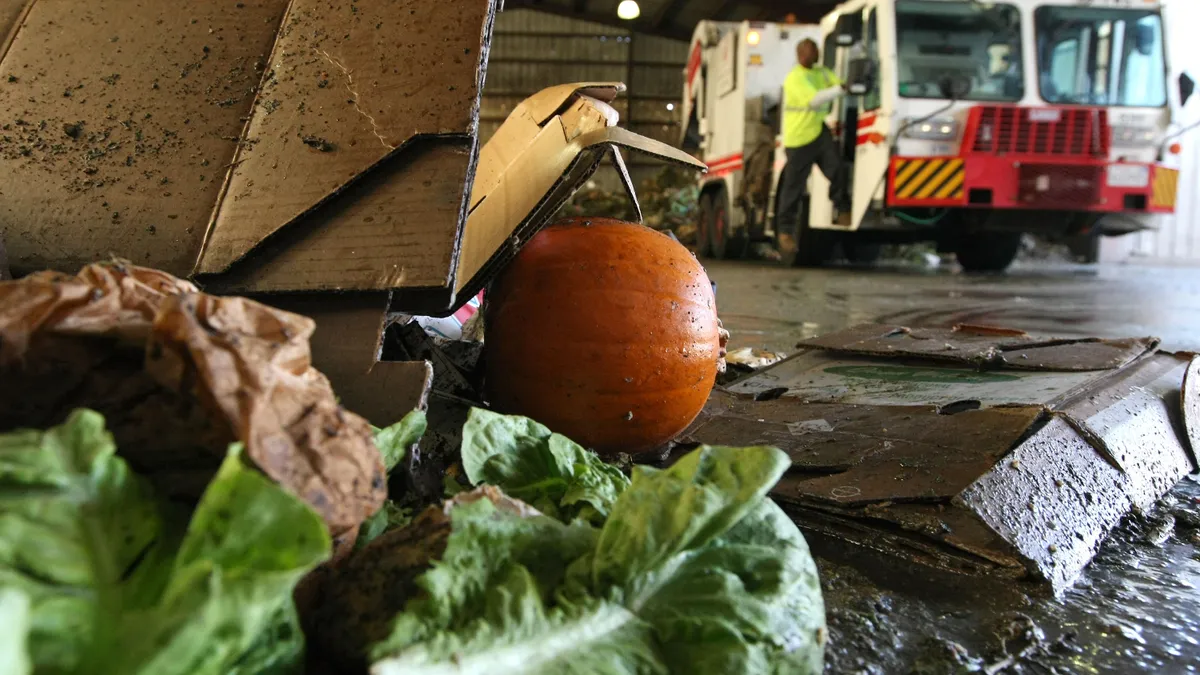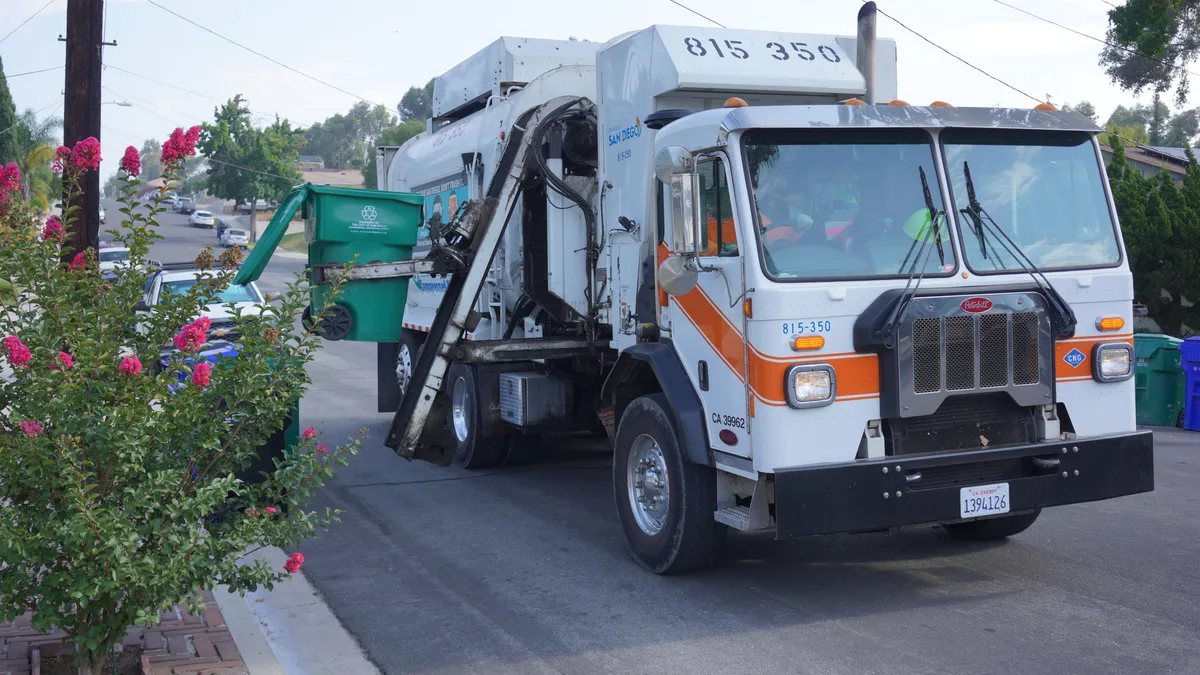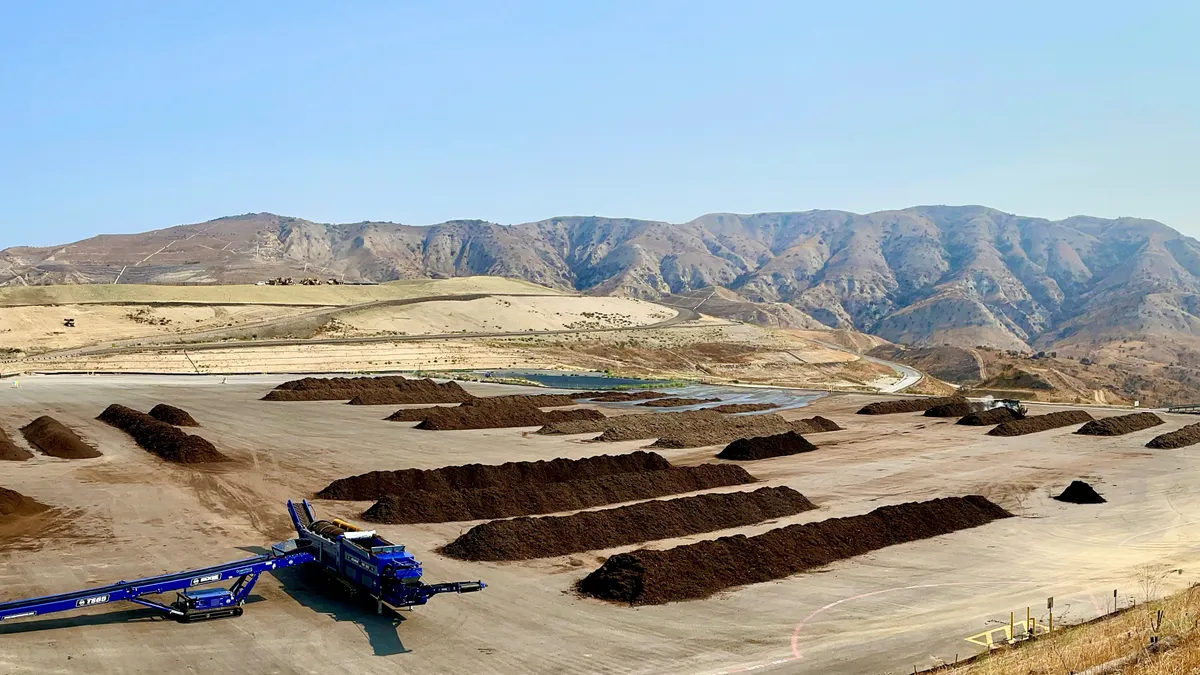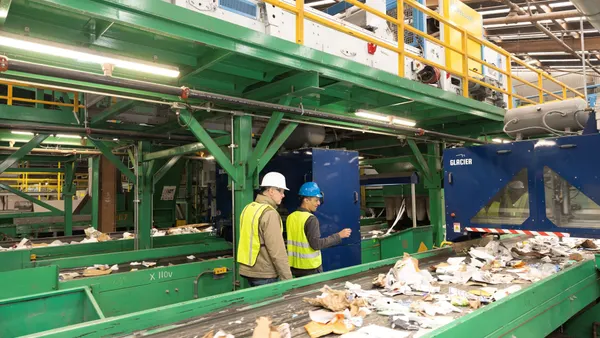Editor’s note: This is the second in a multipart series exploring the market effects of California’s sweeping organic waste reduction law, SB 1383.
The questions of how — and how much — to grow California’s capacity for organics processing to meet the requirements of SB 1383 have spurred notable investments and competition among public- and private-sector operators alike in recent years.
Some have described SB 1383 as driving the sector’s largest infrastructure deployment since the advent of single-stream recycling, and companies that implemented that effort are involved once again.
Many of the state’s largest haulers — WM, Republic Services, Recology and others — are investing in new composting facilities, primarily ones that use or are converting to aerated static pile systems, which are well-suited to process source-separated organics. Other companies, such as Anaergia, have invested in anaerobic digestion facilities they say are important to handle more complex, mixed streams. As this all plays out, stakeholders throughout the state are also looking for ways to bolster end markets and assess the long list of trade-offs involved with different approaches.
WM, for one, has expanded some of its California organics infrastructure through acquisitions over the years, and it intends to develop additional facilities. Among its customers with organics recycling, three-cart collection systems are the most prevalent.
The company has said that its big-picture focus in California is on composting infrastructure versus anaerobic digestion because it can still access third-party digestion capacity where needed, but it is continuing to “evaluate and explore additional technologies,” including digestion. WM currently has four composting facilities in the state, plus one CORe pre-processing plant for codigestion and OREX extrusion press technology from Anaergia — a company that specializes in anaerobic digestion and organics pre-processing — at one site.
“For most of our customers, we do have options. Now, do we still need additional facilities? The answer is yes,” said Alex Oseguera, the company’s director of government affairs in California. If volumes come in as expected, then the industry “will definitely need additional facilities across the state," he said.
Republic Services hired Chris Seney as its director of organics operations in 2018, after he spent many years in the compost sector, with SB 1383 preparation and the development of organics infrastructure as his top mandate. He said getting any type of organics recycling facility permitted lately has become “extremely difficult,” and it’s often a multiyear process. The company recently opened California’s first fully solar-powered composting facility in San Diego County.
Overall, Republic has six compost sites in the state (plus one nearby in Arizona), along with three commercial pre-processing facilities. Seney said the company views composting as the more proven and economical approach than anaerobic digestion, though Republic does use some digestion facilities.
Seney said that in many cases, jurisdictions that are already doing yard waste collection are looking to co-collect food scraps in that bin, adding them to a stream that is well-suited for composting. This helps maintain a three-bin system that is also considered the “most economical method” of SB 1383 compliance, he said.
“It is a proven system. The outcome is guaranteed as it can possibly be. If you put out there a gray bin for MSW nonorganic [waste], a green container for organics, a blue container for recyclables, you are compliant with 1383 with that three-container solution,” said Seney.
Recology is similarly focused on composting, with five sites in the state, including a large operation near Vernalis that can handle more than 1,200 tons per day — almost half of which comes from San Francisco — and another near Lamont. Company spokesperson Robert Reed said via email that the latter facility, near Los Angeles, “has permitted capacity to receive far more, giving cities in this populous region a professional place to send their compostable materials.” Recology’s other composting facilities also have additional capacity.
As for the company's recommended collection approach, Recology also leans toward the most common model that it helped originate.
“Land use can differ greatly from city to city, so there is no single program that is perfect for all locations. That said, the 3-bin program pioneered in San Francisco achieves numerous and significant benefits,” said Reed. “Customers find it easy and convenient to place their recyclables in one bin and compostable materials in another.”
The case for anaerobic digestion and mixed waste collection
Environmental engineer Eugene Tseng and some other experts in the organics recycling market say California won’t be able to reach its organics diversion goals solely through three-bin collection that goes to composting or anaerobic digestion. Plus, when factoring in all of the trade-offs involved, that approach will be more expensive, they say.
“Most Californians cannot afford to have three bins, and the compost facilities are not set up to take the tsunami of food waste and the contamination that will come with it,” said Yaniv Scherson, chief operating officer of Anaergia. Source-separated collection will be particularly challenging for multifamily and commercial customers, he added.
Anaergia’s approach is to use an extrusion press — known as the OREX, short for organic extraction — to push a wet organic fraction out of certain types of mixed waste streams. The fraction goes from the three OREX machines operating in California to codigestion facilities at wastewater treatment plants or standalone digesters such as the company’s recently opened facility in Rialto, east of Los Angeles. That facility is permitted for up to 700 tons per day of organics and 300 tons of biosolids. It’s one of the few large-scale digesters built in California recently; others are operated by CR&R in Perris, Mustang Renewable Power Ventures in Santa Barbara and EDCO in San Diego County.
“As more food is commingled in green waste, composting sites will have limitations and surcharges for the increase of contamination that inevitably comes, and limitations on just how much food you can compost,” said Scherson. “That’s really where I think AD is going to play an early penetration role in the market.” Anaergia is particularly interested in the potential to utilize existing capacity at an estimated 150 wastewater treatment plants in the state that could be eligible for a codigestion facility, with Scherson noting he views this as a key way to help reach the state’s decarbonization goals.
While many of the major waste haulers say they don’t see a business case for financing their own digesters, they do use some existing facilities in areas such as Los Angeles, where a commercial waste franchise program that started in 2017 already required major organics investments. With OREX units operating at WM and at local hauler Universal Waste Systems, Scherson said Anaergia is likely processing about half of the city’s commercial organics.
WM’s Sun Valley facility, which has an OREX system that handles source-separated and mixed streams, was the site of a recent case study, conducted with the local city/county enforcement agency in Los Angeles, to assess measurement standards for verifying compliance of high-diversion facilities. Under SB 1383, jurisdictions allowing mixed waste collection will need to prove the processing facility they’re using meets the “high diversion” criteria of at least a 75% recovery rate by 2025.
According to those involved, including Scherson and Tseng, the initial regulatory language required labor-intensive and potentially dangerous manual sorting of the wet residual stream after it had been processed. CalRecycle recently approved a new methodology for evaluating outbound organic material from this facility, which minimizes the need for manual assessments and has attracted attention from others in the state.
Some view the future of these high-diversion facilities as uncertain, given concerns about organic material potentially being degraded in a commingled stream and losing value. Detractors also note it’s unclear whether any facilities in the state can achieve the 75% recovery rate threshold. CalRecycle doesn’t expect to have such data until next year.
Even so, some jurisdictions are pursuing that path toward compliance with SB 1383. The Western Placer Waste Management Authority recently awarded a contract to FCC Environmental Services to take over operations of its mixed waste MRF and pursue new upgrades. That project will also involve an upgrade of the authority’s yard waste composting site.
Athens Services in the Los Angeles area is another commonly cited example of a company that specializes in mixed waste. Multiple jurisdictions contract with the company for collection in the San Gabriel Valley, where Athens operates Los Angeles County’s largest mixed waste MRF, as well as a large composting operation in the region. Athens was not available to comment for this story.
Other mixed waste processing facilities in the state include the Sunnyvale SMART station. Sunnyvale awarded a contract to a GreenWaste Recovery subsidiary to operate the facility for sorting four streams — yard trimmings, 2-inch-minus MRF fines, source-separated residential and commercial food scraps — and, eventually, compostable food-soiled paper products. GreenWaste currently has the contract to compost those streams. GreenWaste’s operations in San Jose also sort mixed waste from residential customers.
“We’re not worried about meeting the diversion requirements and all the various requirements for a high-diversion organics facility. We either are already there or are very close to getting there with a few additions,” said Greg Ryan, chief operating officer of GreenWaste, adding that these systems are important because sorting behaviors by customers are erratic. “Ultimately, with all the auditing and verification on the mixed waste processing facilities, I’m confident you’re going to have much higher diversion in the mixed waste system."
Permitting process has been a barrier to growth
Ryan said one reason there aren’t as many mixed waste processing facilities is it can take several years to design, permit and build such operations. Doing so within the short window between SB 1383’s regulations being finalized and being implemented would be nearly impossible. If not for San Jose taking a step in this direction with a 2011 contract, Ryan said the city’s infrastructure likely would not be scaled up yet, either.
Bill Camarillo, CEO of compost company Agromin, said he is painfully familiar with the long timeline to scale up. Agromin currently operates 21 organics processing and composting facilities in the state, not all of which accept food waste. It produced and marketed more than 1 million tons of compost last year, which the company says makes it the state’s largest organics recycler.
Camarillo’s company had been trying to get a facility permitted in Santa Paula for 12 years; it finally received the sign-off in February. The delays were due, in part, to evolving plans for the facility’s scope, he said, to keep up with growing demand for organics processing capacity as the state continues passing new laws, but also due to bureaucratic hurdles. While the four-year permitting time frame for another facility in Oxnard was relatively quicker, it still shows the complexities involved.
“It’s a heck of a minefield to be navigating to figure out how to permit commercial compost centers in today’s environment,” said Camarillo. The main issue is that the various permitting bodies that oversee water, air, land use and local planning are not in sync, he said. Plus, as projects drag on, it’s not uncommon to see staff turnover at these agencies, which presents a further learning curve. “Once you get into the cog of planning, you might as well be trying to build a housing development, you’re just stuck in there forever," he said.
As this work continues in the years ahead, California will surely see further investment in more organics processing capacity. CalRecycle Director Rachel Machi Wagoner said the permitting issue is “very much on our mind.” The agency has been speaking with a range of government entities about how “to streamline the permitting process to assist facilities to get built where we need them built,” she said, but the issue will remain complex.
Market momentum
In many commodity markets, supply grows to meet demand, and SB 1383 has created mechanisms to increase demand for the products that will come out of increased organics processing such as compost, mulch and renewable energy. One state estimate indicates the law could yield "an additional 5.5 million tons of compost and more than 14 billion cubic feet of biomethane" by 2025.
California is mandating a massive scale-up in procurement activity by cities and counties to bolster markets for these “organic waste products” while allowing some flexibility in what the jurisdictions choose to purchase. The annual procurement requirements for jurisdictions are based on population size, so, for example, Los Angeles will be expected to procure at least 313,867 tons of organic material this year. Some have raised questions about how cities can actually use this much material, leading the city of South San Francisco to team up with its county conservation district to give some of its procured compost to county farmers.
Matt Cotton, principal and owner of Integrated Waste Management Consulting, said California is well-positioned to find markets for its growing volumes. He pointed to 2019 research from the University of California, Merced, that found farmlands have sufficient capacity to take a large share of finished compost that will come from the law, with positive soil benefits, and green space within cities is another area with untapped potential.
“We have almost unending agricultural markets,” he said, going on to note how California grows the largest amounts of dozens of key agricultural commodities in the U.S. “Markets [for compost] are not the problem in California.”
A 2019 market study by Cotton identified agricultural markets as the largest destination for products from recycled organics by far, taking 65% of the state's supply, and 85% of the supply of compost specifically. From there, landscaping and nursery applications were the next-highest uses, along with a mix of other small but growing opportunities in transportation projects and others.
Adding compost to crops is a win-win, many say, because of its ability to sequester carbon in soil and advance climate change efforts. Recology’s Reed is a particularly energetic believer in this application, regularly emailing statistics and stories about how farms have benefited from using compost.
“Farms want Recology compost because it helps them grow more food and save water,” he wrote, “and many vineyards and orchards use Recology compost to grow mustard and other cover crops to pull carbon and nitrogen out of the atmosphere and push them deep into the soil where they belong.”
While these benefits are widely accepted, the reality of what it takes to turn collected organics into a product that will be desirable enough to be used at a wide scale is more complex. California has robust markets for agricultural compost, and it is expected to see even greater demand for a range of products due to SB 1383’s procurement requirements, but it also has strict standards for material quality.
“The reason you’re diverting the organics is obvious, because of landfill methane reduction and avoidance, but you want to produce a material that can go back to the soil to do all the good things that a digestate or a compost or direct application can do,” said Nora Goldstein, editor and publisher of BioCycle, and a longtime organics industry observer who is also a strong believer in the powers of compost. She warns, however: “What I keep hearing over and over again is [that] the contamination in the food waste stream is so high that, basically, what we’re going to see at the end of the day is really contaminated compost.”
Haulers, organics recyclers and local governments point to their pre-processing equipment, education programs and other mechanisms as ways they will ensure a clean stream, but all involved recognize it’s still a challenge — especially as more food waste enters systems that have been designed for or accustomed to the simpler green waste stream.
“As we expand rapidly into adding food waste, food scraps co-collected in green bins or with mixed organic streams, I think that market challenges might be coming where at some point there’s going to be resistance,” said Neil Edgar, senior project manager with the firm Edgar & Associates and executive director of the California Compost Coalition. He believes that demand may not expand in parallel with the supply. “There’s a shortage of infrastructure already” for a more complex organics stream, he said, “and I’m not sure how quickly that’s going to resolve so that you have enough permitted capacity for mixed organics across the state.”
Edgar said contamination concerns are even greater for mixed waste collection — a one- or two-bin system with MSW and food collected together. “It’s much more difficult to create marketable products out of commingled mixed waste,” he said.
Not all organic material will become compost, however. Some will be processed in anaerobic digestion facilities to produce biogas, a form of renewable natural gas. While some jurisdictions are looking at ways to meet the procurement requirements by purchasing biogas created by anaerobic digestion facilities, Scherson said that aspect of the market is less developed because SB 1383 didn’t assign any monetary value to the gas, which could have helped make it a more competitive option.
The California Public Utilities Commission recently finalized biogas procurement targets for the state’s utilities mandated by a 2018 law, a development Anaergia welcomed, as it “levels the playing field” in terms of competition with gas from out-of-state dairy operations in the Low Carbon Fuel Standard, Scherson said.
As new jurisdictions begin to ramp up their organics collection programs, and more established ones work to maximize their existing operations in order to meet new regulatory requirements, California’s organics recycling experiment is still in its early stages. Numerous questions remain about infrastructure funding, potential shortcomings of different collection approaches, the implications for the business models of major industry companies and more.
CalRecycle’s Machi Wagoner said the agency is cognizant of all these factors, but it views this as a transitional time toward an inevitable outcome that ultimately could lead to a further shift away from disposal — which still is the destination of most material collected by local governments and waste companies.
“It’s no longer a liability. It's an actual commodity,” said Machi Wagoner, speaking about organic waste. “That's where the future of this business is. That's where the money is going to be. We've given a regulatory structure for a new commodity. It's like making money out of nothing.”
Stay tuned for Part 3, which will explore the many logistical and financial questions jurisdictions have been working through during the pandemic years to meet the requirements of SB 1383.



